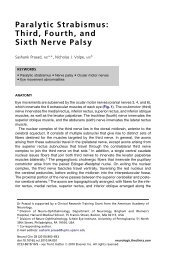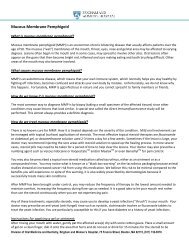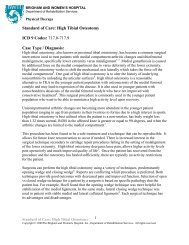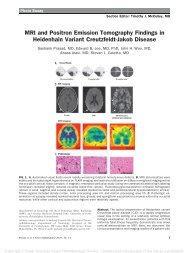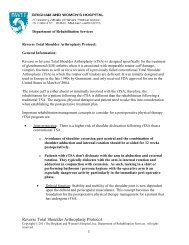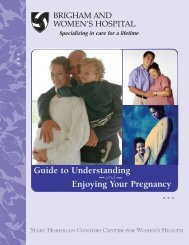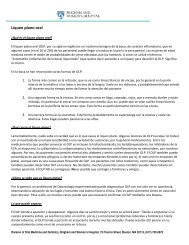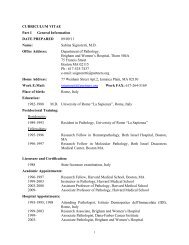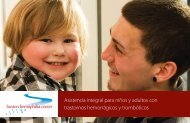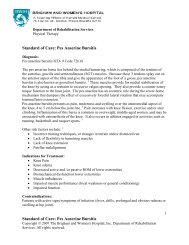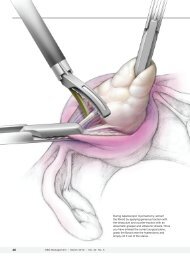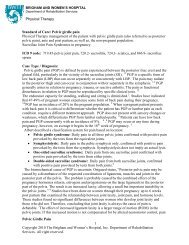Reverse TSA with LDTT Protocol - Brigham and Women's Hospital
Reverse TSA with LDTT Protocol - Brigham and Women's Hospital
Reverse TSA with LDTT Protocol - Brigham and Women's Hospital
Create successful ePaper yourself
Turn your PDF publications into a flip-book with our unique Google optimized e-Paper software.
Department of Rehabilitation Services<br />
• Continuous cryotherapy for first 72 hours postoperatively, then frequent application (4-5<br />
times a day for about 20 minutes).<br />
• Insure patient is independent in bed mobility, transfers <strong>and</strong> ambulation<br />
• Insure proper gunslinger fit/alignment/ use.<br />
• Instruct patient in proper positioning, posture, initial home exercise program.<br />
• Provide patient/ family <strong>with</strong> written home program including exercises <strong>and</strong> protocol<br />
information.<br />
Day 5 to 28:<br />
• Patient continues all exercises as above at home.<br />
• Frequent (4-5 times a day for about 20 minutes) cryotherapy.<br />
4 Weeks to 6 Weeks:<br />
• Patient typically begins formal outpatient physical therapy.<br />
• Progress exercises listed above.<br />
• Begin sub-maximal pain-free deltoid isometrics in scapular plane (avoid shoulder<br />
extension when isolating posterior deltoid.)<br />
• Begin shoulder PROM:<br />
o Forward flexion <strong>and</strong> elevation in the scapular plane in supine to 120 degrees as<br />
tolerated.<br />
o NO IR PROM at this time.<br />
o ER in scapular plane to tolerance, respecting soft tissue constraints (typically 30-<br />
40 degrees of ER).<br />
• Continue frequent cryotherapy.<br />
Criteria for progression to the next phase (Phase II):<br />
• Tolerates shoulder PROM <strong>and</strong> deltoid isometrics; <strong>and</strong> AROM program for elbow, wrist,<br />
<strong>and</strong> h<strong>and</strong>.<br />
• Patient demonstrates the ability to isometrically activate all components of the deltoid<br />
<strong>and</strong> periscapular musculature in the scapular plane.<br />
Phase II –Active Range of Motion / Early Strengthening Phase (Week 6 to 12):<br />
Phase II ADL’s<br />
• Independent dressing <strong>and</strong> showering below 90deg shoulder elevation<br />
<strong>and</strong> <strong>with</strong> upper extremity in front of patient.<br />
• Use caution to prevent jerking motions when don/doffing clothing.<br />
• Use of operative arm to eat/drink <strong>and</strong> perform light activities.<br />
• No lifting of objects more than 2-3 pounds <strong>with</strong> operative upper<br />
extremity.<br />
<strong>Reverse</strong> Total Shoulder Arthroplasty <strong>with</strong> Latissimus dorsi tendon transfer <strong>Protocol</strong><br />
Copyright © 2008 The <strong>Brigham</strong> <strong>and</strong> <strong>Women's</strong> <strong>Hospital</strong>, Inc. Department of Rehabilitation Services. All rights<br />
reserved.<br />
6



